We start the day with a leisurely breakfast. Sandra and Skye opt for a freshly made omelette, while Ryo comes back with a curious choice of sausage, salami and mortadella… only none is pork-based so he is quite disappointed with the taste!
We pack the strict minimum for the desert, check out and leave our suitcases at the reception desk. Aubid picks us up shortly after 10:30. While heading to the mountains, two western women on bikes stop our car to ask our guide if there is another way to Salalah than the main road. They already witnessed two accidents and are scared. Sure enough, there is a car engulfed by flames just a little farther on. On our way up we stop at a water hole and explore enormous termite mounts. The mountains here used to be covered in trees, but drought, camels and cows have taken their toll and the pasture is quite meagre, so the cattle are fed hay once the Khareef (monsoon) green is gone.
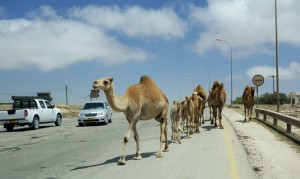
On the way through the mountains Aubid makes a detour through his village in the mountains to pick up a few things, and invites us inside his house for tea. His mother joins us. She has an impressive nose ring and wears a thobe (robe) and veil. We sit in the traditional reception room, on cushions on the floor. Aubid lives here with his mother, wife and 15 year-old daughter. We enjoy our first taste of ginger-infused Omani tea, then he shows us his garden were he grows a frankincense tree, some medicinal plants and a tree with lots of little fruits: he tries one but it’s too bitter. If you’re hungry enough, you’ll eat it! he says. The family also keep goats in a pen, but their camels roam freely in the mountains. Aubid’s tribe is Mahari, and they have their own language that is not Arabic. The family also speaks Shahari. We notice also that the houses in the village are covered in a dark grey layer of grime. This deposit comes from the Khareef fog which envelops the area during the monsoon. We spot farmers packing up a big truck with bags of manure, and discover later where this is destined for.
Next stop is the Wadi Dokar where frankincense trees are cultivated by the thousands. They’ve just recently set up the area with a parking lot, information signs and a toilet. We admire the special trees and the backdrop or rocky desert and cone shaped hills. Later we also see a gigantic gypsum mine with huge piles of white material that is used in ceramic production.
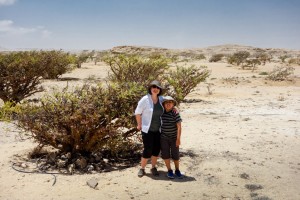
In Thumrait, we enjoy a tasty Pakistani lunch in an incredibly cheap greasy spoon… um, no sorry, greasy finger, as it quickly dawns on us that there will be no utensils provided. Ryo remarks that it would have been useful if they knew the word “Shauze”, the Chinese word for spoon which he had gotten used to ask for during our trip in China last year. But we do a great job cleaning up our 1 Rial (2 Swiss Francs!) chicken curry with the big chapattis we ordered. There are some family rooms at the back of the restaurant but we elect to stay in the front room. Sandra is the only woman in the place, as they do not eat in public in front of men. We imagine she is just as out of place as a fully-veiled woman would be in a restaurant back home, but we are dutifully ignored as Omanis are tolerant with foreigners.
We leave the road for Muscat (almost 1000 kms of monotonous flat rocky desert) turning in the direction of the lost city of Ubar were we discover the ruins of the ancient city and also the end of the paved road. In this area, it’s just a big rocky desert like you’re on Mars, and then all of a sudden you come across big patches of green fields. In fact, there is a water table under the rocky plains that stretch as far as the eye can see, so the farmers spread thousands of bags of manure, install huge irrigation systems and create these surreal fields where they grow grass to feed the camels and cattle. It’s like in the film “the Martian”, but with hay instead of potatoes.
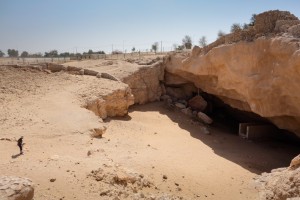
Once the road ends, the true desert begins, a flat expense of rocky plain, crisscrossed by dried-up wadis and stretches of mini dunes and rocky hills. The landscape from the beginning of the trip is austere but incredibly mesmerizing. The track is rough and we follow an endless series of electricity poles, until after a long while we start to glimpse some golden mountains on the horizon… we are nearing the Empty Quarter. Suddenly Aubid leaves the track and plunges toward the dunes. The sun is low and the light is superb to admire the first dunes, and once the 4×4 leaves the rocky plain, Aubid stops to let some air out of the tires to be able to drive in the sand. Sandra is overwhelmed by the scenery and gets a bit emotional at finally seeing the mythical Rub al Khali. Ryo throws himself in the sand with delight and Skye starts firing the first of hundreds of pictures of the dunes: everywhere you turn a new perspective presents itself. After a fun drive around the dunes, going deeper into the sands but only just scratching the surface of mighty desert that stretches far away to Yemen and Saudi Arabia, we finally reach our camp. The wind that has blown strongly all day is not going down and has toppled part of the palm-leaf windbreak erected about the big Bedouin tent. Aubid and Skye work to pull it back up again when Aubid’s brother Mussallem arrives with other tourists, a family from Cologne, Germany. Manfred and Yuki and their 15 year-old son Anton join us on the Bedouin mats where we have a pleasant chat. They are on the second week of their vacation and have already toured the North of Oman which we will visit next week.
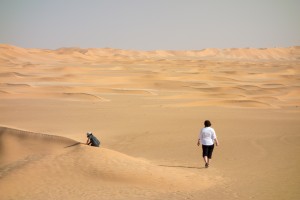
While the two brothers prepare a typical Omani dinner in the tent away from the sand flying everywere, we all climb the gigantic dune right behind our camp. It’s tough work. Anton and Skye reach the top, almost 100m above the plain, while Ryo and Anton’s parents stop mid-way. Determined to conquer the mighty pile of sand, Sandra keeps Skye waiting in the wind but finally makes it, beet red and out of breath. We are rewarded with a 360° view: stranded in a sea of sand, the sun is almost gone now and the wind is still howling. We run back down the dune for dinner. It is considerably easier than the way up!
Mussallem and Aubid have prepared rice and a nice Omani chicken and vegetable dish. We enjoy dinner and chitchat about previous trips with the German family. At one point we hear a very strange noise, a sort of whistling hum made by a sand avalanche when the tip of a dune collapses.
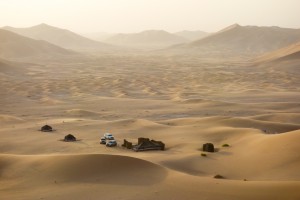
The wind does not deter Aubid who go out into the sandstorm, puts a mattress on a table, wraps himself completely in a sheet and goes out like a light. We westerners set up our beds in the tent. Mussallem is clever, and decides to sleep in his car, away from the pervasive gritty sand.
It’s not a comfortable night of sleep: we are covered in sand, the tent creaks and groans all night in the wind, but the on-and-off sleep allows us to step out to admire the scenery by night. The stars are wonderful, and then the moon rises and we see the dunes outlined in the night. It’s peaceful even with the wind.
Captivant comme récit, on vit carrément la scène. . Non, Romy, tu n’as pas de sable dans les pantoufles …
just a question, why do you not wrap yourself into a sheet instead ont putting them on the mattress? you would get less sand into them no?
We went to Oman last October and had a great time. This brings back memories. Enjoy!